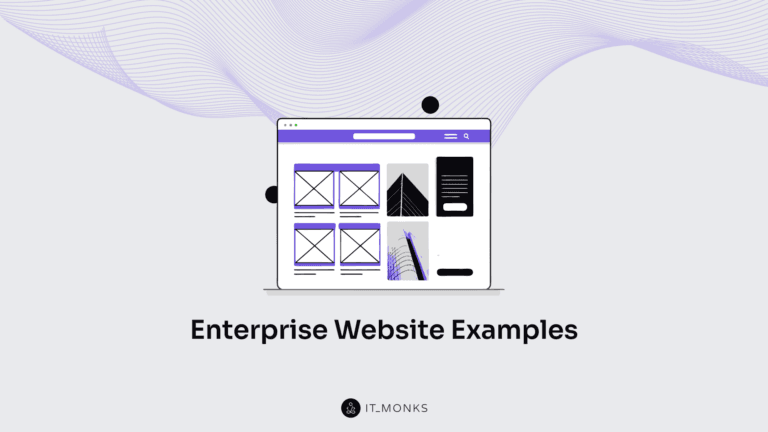Ecommerce Navigation Best Practices
Table of Contents
Table of Contents

Effective navigation is the backbone of any successful ecommerce website. The roadmap guides users to their desired products, making their shopping experience smooth and enjoyable. A well-structured navigation system helps users quickly find what they’re looking for and increases the likelihood of conversions. In this guide, we’ll explore the foundational elements of ecommerce navigation, providing insights into the ecommerce navigation best practices and ecommerce navigation examples to enhance the user experience. Let’s dive in!
The Foundation of Effective Ecommerce Navigation
Creating a robust ecommerce navigation system starts with clearly understanding your users and their needs. By focusing on the key elements that guide visitors through your site, you can ensure that your navigation is intuitive, user-friendly, and aligned with your business’s goals. This guide explores how to understand user behavior, leverage data to design an effective navigation system that enhances the overall user experience and master SEO navigation best practices.
User Intent and Journey
Understanding user intent and the typical customer journey is crucial when designing your ecommerce navigation. Each visitor to your site arrives with specific needs and expectations. Some may browse casually, while others try to find a particular product. You can tailor your navigation to meet their needs by analyzing these behaviors.
For instance, a first-time visitor might appreciate a top-level navigation that clearly outlines product categories, making it easier to explore your offerings. On the other hand, a returning customer may benefit from personalized ecommerce navigation that remembers their preferences and displays relevant products immediately. Aligning your navigation with the user journey ensures a seamless experience, encouraging users to stay longer and explore more.
Eager to create a usable store?
Research and Data
Data-driven decisions are essential to creating an effective ecommerce navigation system. Starting by gathering insights into how users interact with your site is one of the fundamental ecommerce navigation best practices. Tools like heatmaps and user testing can reveal which areas of your navigation attract the most attention and which might be confusing. For example, if users frequently abandon their searches mid-way, your ecommerce filter navigation needs improvement.
The best e-commerce tools for website analytics can also provide valuable information on your site’s most visited pages, popular product categories, and user paths. This data helps you prioritize important links in your ecommerce navigation UX design, ensuring that users can easily access the content they are most interested in. Additionally, WordPress and WooCommerce A/B testing different ecommerce navigation examples can help identify which layouts and structures resonate best with your audience.
Combining a deep understanding of user intent with comprehensive data analysis allows you to create a comprehensive ecommerce navigation UX design system that meets and exceeds user expectations, driving engagement and sales.
Core Navigation Structures and Their Use Cases
Understanding the different types of navigation structures is key to creating a user-friendly ecommerce site. Each structure has its unique benefits and is suited to specific use cases. Let’s explore the main navigation structures that can help guide users efficiently through your site, ensuring they find what they need with minimal effort.
Main Navigation Menus
The main navigation menu is the cornerstone of any ecommerce website. It serves as the primary guide for users, helping them access key areas of your site. Choosing the right user-centered design optimization method and type of main navigation and implementing it effectively can significantly enhance the user experience and make it easier for visitors to explore your products and services.
Horizontal vs. Vertical Navigation
The two primary types of navigation menus are horizontal and vertical navigation, each with its strengths and ideal use cases.
- Horizontal Navigation: This type of navigation displays menu items across the top of the page in a single row. It is widely used for ecommerce websites in a moderate number of categories. Horizontal menus are effective because they keep the primary options visible at all times, making it easy for users to explore different sections. For example, websites like Amazon and Best Buy effectively use horizontal navigation to allow users to access various product categories quickly.
- Vertical Navigation: Vertical navigation typically appears on the side of the page, with menu items stacked one on top of the other. This format is ideal for websites with extensive category lists, providing ample space for subcategories and detailed options without overwhelming the user. IKEA is an example of a site that uses vertical navigation to guide users through its broad range of products.
Choosing between horizontal and vertical navigation depends on the content you must display and how you want users to interact with your site. Horizontal navigation keeps the design clean and focused for sites with fewer categories. In contrast, vertical navigation works best for more complex sites with a deeper hierarchy.
Drop-Down Menus
Drop-down menus are a popular way to organize content under each primary category, helping to keep the navigation bar uncluttered. When a user hovers over or clicks a menu item, the drop-down menu appears, revealing additional options or subcategories. This is one of the ecommerce navigation best practices for sites with a broad product range, allowing users to quickly drill down to specific sections.
However, drop-down menus come with potential pitfalls. If not designed carefully, they can overwhelm users with too many options or make navigating difficult on mobile devices. To avoid these issues:
- Keep it Simple: Limit the number of items in each drop-down menu to prevent users from being overwhelmed with choices.
- Ensure Accessibility: The drop-down menu should be easily navigable with both mouse and keyboard and work smoothly on touch devices.
- Consider Delays: Implement a slight delay before the drop-down menu appears to prevent it from accidentally triggering when a user’s mouse briefly hovers over a menu item.
Effective ecommerce navigation examples with drop-down menus can be seen on sites like Nike, where users can easily navigate different product categories without cluttering the main navigation bar.

Supporting Navigation Elements
In addition to the main navigation menus, supporting navigation elements play a crucial role in enhancing the overall usability of your ecommerce site. These elements help users find specific products, retrace their steps, and access important information quickly and easily. Implementing these elements thoughtfully can lead to a more intuitive and satisfying shopping experience.
Search Bar
A search bar is an essential navigation tool, especially for ecommerce sites with large product catalogs. It allows users to bypass the navigation menus and go directly to the products or information they seek. A prominent, easily accessible search bar can significantly improve online commerce navigation UX by reducing the time it takes for visitors to find what they need.
To enhance the functionality of your search bar, consider incorporating features like:
- Autocomplete: As users type, suggestions appear based on popular searches, helping them find products faster.
- Filters: Allow users to refine their search results by criteria such as price, brand, or rating, making it easier to narrow down options.
- Voice Search: As voice search becomes more common, consider adding this feature to cater to users who prefer speaking over typing.
Leading ecommerce sites like eBay effectively utilize advanced search bar features along with other ecommerce navigation best practices to streamline customers’ shopping experience.

Breadcrumbs
Breadcrumbs are a secondary navigation aid that shows users their path through the site, typically displayed in the top-level navigation, just below the main navigation bar. They provide a clear trail of how users arrived at their current location, making it easy to backtrack to previous categories or sections.
Breadcrumbs improve navigation by:
- Enhancing User Orientation: On deep or complex sites, users can see where they are in the site’s hierarchy.
- Reducing Clicks: Instead of using the back button or starting over from the home page, users can click breadcrumb links directly to higher-level categories.
For example, a breadcrumb trail on a site like Wayfair might look like this: Home > Furniture > Living Room > Sofas, allowing users to jump back to any of these categories with a single click.

Footer Menus
Footer menus provide access to important secondary content and resources that must be more critical to feature in the main navigation. They are usually located at the bottom of every page and often include links to pages like the privacy policy, terms of service, customer support, and additional company information.
Footer menus are valuable because they:
- Offer Accessibility: Users can find important information without navigating away from their current page.
- Improve SEO: Footer links can help search engines understand your site’s structure and the importance of certain pages.
- Enhance User Trust: The footer’s easy access to policies, support, and company details can reassure users of your site’s credibility.
Websites like ASOS utilize ecommerce navigation best practices for footer menus effectively to house secondary navigation options, ensuring that users can easily access the information they need, no matter where they are on the site.

Designing for the User: Best Practices in Ecommerce Navigation
Designing effective ecommerce navigation is about more than just placing links and buttons on a page — it’s about creating an intuitive and efficient experience for your users. By focusing on logical structure and consistency, you can ensure that visitors can easily find what they’re looking for and have a seamless browsing experience. Let’s delve into navigation UX best practices for achieving this.
Need to enhance ecommerce UI/UX?
Creating a Logical Structure
A well-organized navigation structure is crucial for helping users find products quickly and efficiently. This involves grouping products into clear categories and subcategories and ensuring that labels are descriptive and intuitive.
Category Organization
To create a logical structure for your ecommerce site:
- Group Products Intuitively: Organize products into categories that make sense from a user perspective. For instance, a clothing retailer might categorize products into Men’s, Women’s, and Kids’, with further subcategories like Shirts, Pants, and Accessories.
- Use Clear, Descriptive Labels: Labels should be straightforward and match common user expectations. Instead of using internal jargon, opt for terms users will likely search for or understand immediately. For example, instead of “Apparel,” use “Clothing” or “Men’s Clothing.”
- Consider User Behavior: Analyze search queries and browsing patterns to refine your categories. If users frequently search for specific product types, ensure these are prominently featured in your navigation.
Home Depot is one of the ecommerce navigation examples that has an effective category organization. Products are logically grouped and clearly labeled, making it easy for users to navigate various options.

Consistency is Key
Consistency across your ecommerce site is one of the fundamental navigation UX best practices. When navigation elements are uniform and predictable, users can focus on finding products rather than figuring out how to use the site.
- Site-Wide Uniformity: Ensure that navigation elements are consistent across all pages. This includes maintaining the same menu structure, labels, and visual design. Users should be able to navigate your site intuitively without relearning the layout as they move from page to page.
- Sticky Navigation: Implement sticky navigation bars that remain visible as users scroll. This feature helps users access the main menu without having to scroll back to the top of the page, enhancing usability and reducing friction.
- Design Consistency: Apply a cohesive design language to all navigation elements. This means using consistent colors, fonts, and iconography throughout the site. Consistent design helps users quickly recognize navigation elements and understand their function.
Sites like Apple exemplify consistent navigation design, providing a predictable and user-friendly experience across their extensive product catalogs and multiple pages.

Simplicity and Clarity
In ecommerce navigation, especially in terms of SEO navigation best practices, simplicity and clarity are crucial for ensuring that users can quickly and easily find what they need without feeling overwhelmed. By adopting a minimalist approach and focusing on essential elements, you can create a more intuitive and user-friendly experience.
Less is More
One core principle of effective navigation is to keep it simple. Limiting the number of navigation items helps avoid overwhelming users and makes it easier for them to find their way around your site.
- Prioritize Key Items: Focus on including only the most essential navigation links. More options can create cognitive overload and make it easier for users to make decisions. For instance, instead of listing every product category, feature only the primary ones and use subcategories where necessary.
- Use Concise Labels: Choose short, clear labels that convey the purpose of each navigation item without ambiguity. For example, instead of “Find Out More About Our Latest Products,” simply use “New Arrivals.”
- Incorporate Clear Icons: Enhance labels with intuitive icons visually representing the content. This can help users quickly identify navigation options and improve overall usability.
An example of this approach can be seen on Google’s homepage, which features a minimalistic design with a few essential navigation items and a clear search bar. This makes it straightforward for users to navigate and find information.

Avoiding Clutter
Cluttered navigation can detract from the user experience, making it difficult for visitors to focus on their goals. Here are some tips for maintaining a clean and effective navigation system:
- Implement Visual Hierarchy: Use cues like font size, color, and spacing to emphasize important navigation elements. This helps users quickly identify key sections and reduces visual noise. For example, primary categories might be displayed in larger, bold text, while subcategories are in smaller, lighter text.
- Utilize Whitespace: Adequate spacing between navigation items prevents the interface from feeling cramped and overwhelming. Whitespace improves readability and makes it easier for users to scan through options. Ensure enough padding around each item to create a balanced, uncluttered layout.
- Focus on Essential Links: Remove or hide less critical links that do not contribute to the primary navigation goals. To keep the main navigation clean, consider using footer menus or expandable sections for secondary information.
Websites like Airbnb excel in decluttering their navigation by focusing on essential links, using visual hierarchy, and incorporating ample whitespace. This approach enhances user experience by making navigation straightforward and visually appealing.

Adapting Navigation for Mobile Users
As mobile usage continues to rise, designing navigation that performs well on mobile devices has become essential. Mobile users interact with sites differently than desktop users, so it’s crucial to consider mobile-first and responsive web design principles and adapt navigation UX best practices to ensure a seamless experience across all devices.
Want to create a mobile-first store?
Mobile-First Design
Mobile-first design prioritizes the mobile user experience and then scales to larger screens. This approach ensures that your site’s navigation is optimized for mobile devices, providing a smooth and intuitive experience for users on smaller screens.
- Hamburger Menus: One of the most common solutions for mobile navigation is the hamburger menu, a collapsible menu icon typically represented by three horizontal lines. When tapped, it reveals the navigation options, helping to conserve screen space. However, ensure that the hamburger menu is easy to locate and access.
- Touch-Friendly Elements: Design navigation elements to be touch-friendly, with ample spacing between clickable items to prevent accidental taps. Buttons and links should be large enough to easily interact with, adhering to touch guidelines and enhancing usability.
- Simplified Menus: Mobile devices have limited space, so simplifying menus is important. Prioritize the most important navigation links and categories. Use dropdowns or expandable sections to organize additional options without cluttering the screen.
For example, Amazon uses a hamburger menu for mobile navigation, offering a clean interface that allows users to access various categories and features without overwhelming the screen.

Optimizing Mobile Navigation
To ensure that your mobile navigation remains effective and user-friendly, consider the following navigation UX best practices for optimization:
- Prioritize Key Links: Based on user behavior, identify the most important navigation links and prominently place them. Links to essential sections such as product categories, search functionality, and account details should be easily accessible.
- Use Sticky Navigation: Implement sticky navigation bars that remain visible as users scroll the page. This feature keeps key navigation links within reach, allowing users to quickly navigate to different sections without scrolling back to the top-level navigation.
- Enhance Search Functionality: Given the limited space on mobile screens, a robust search feature becomes even more critical. Ensure the search bar is easily accessible and includes features like autocomplete and filters to help users find products quickly.
- Test and Iterate: Regularly test your mobile navigation with real users to identify issues or areas for improvement. Gather feedback and make adjustments based on user behavior and preferences to enhance the mobile experience continuously.
Etsy is a prime example of effective mobile navigation optimization. It features a prominent search bar, easy-to-access categories, and a sticky navigation bar that simplifies the user experience on smaller screens.

Enhancing Navigation with Advanced Techniques
Advanced navigation techniques can significantly enhance user experience by providing tailored, efficient ways to discover and interact with content. Leveraging personalization, faceted navigation, and mega menus can help create a more dynamic and user-friendly ecommerce site.
Personalization and Dynamic Navigation
Personalized navigation adapts to user preferences and behaviors, offering a more tailored and engaging experience.
- Behavior-Based Recommendations: Personalized navigation can highlight relevant products and categories by analyzing user behavior, such as browsing history and past purchases. For instance, if users frequently search for running shoes, the navigation might prominently feature sports footwear or related promotions.
- Dynamic Content: Implement dynamic elements that adjust based on user interactions. For example, a homepage might display recently viewed items or personalized offers based on the user’s shopping habits.
- Segmentation: Create different navigation experiences for user segments, such as new visitors, returning customers, or VIP members. This segmentation allows for targeted content and offers that align with user interests and engagement levels.
Sites like Netflix exemplify this approach by providing personalized content recommendations and customized navigation based on user viewing history, enhancing overall engagement and satisfaction.

Faceted Navigation for Product Discovery
Faceted navigation allows users to filter and refine product searches based on multiple criteria, making it easier to find specific items.
- Ecommerce Filter Navigation Options: Offer various filters, such as price range, size, color, and brand. Ensure these filters are easy to use and understand. For example, a clothing store might include size, color, and fabric type filters to help users narrow their choices.
- Visible and Accessible Filters: Position filters prominently and ensure they are easily accessible. Users should be able to apply or remove filters quickly without navigating away from the page. Consider using checkboxes, sliders, or dropdowns for filter options.
- Clear Results: Ensure filter applications update the product results and provide feedback to users when no results match their criteria. This transparency helps users understand the impact of their filtering choices.
An example of effective faceted navigation can be seen on Zappos, where users can filter products by various attributes, helping them find exactly what they’re looking for quickly and efficiently.

Mega Menus
Mega menus are large, expandable menus that simultaneously display multiple site navigation options, making them ideal for sites with extensive categories or subcategories.
- When to Use Mega Menus: Mega menus are appropriate for ecommerce sites with a wide range of categories and subcategories. They are particularly useful for sites offering a wide variety of products or services and must present multiple options clearly and organized.
- Organize with Hierarchy: Structure mega menus with a clear hierarchy, using headings and subheadings to categorize content logically. Group related items together and use visual cues such as icons or images to enhance readability and user understanding.
- Avoid Overwhelm: While mega menus offer extensive options, they should be manageable. Use visual design principles to balance the amount of information displayed and avoid clutter. Incorporate hover effects or click-to-expand features to manage space and keep the interface clean.
Websites like Best Buy effectively use mega menus to organize their vast product catalogs. These menus provide users with a comprehensive overview of available categories and subcategories without overwhelming them with too much information at once.

Common Pitfalls and How to Avoid Them
While implementing effective ecommerce navigation, it’s crucial to be aware of common pitfalls that can undermine the user experience. Avoiding these mistakes can significantly affect how users interact with your site and ultimately impact their satisfaction and conversion rates.
Overloading Menus
Overcrowded site navigation menus can overwhelm users and make finding what they’re looking for difficult. When menus are packed with too many options, users may struggle to locate key features or products, leading to frustration and potential abandonment.
- Keep it Simple: Limit the number of items in your primary site navigation menu to the essentials. Prioritize the most important categories and links to prevent confusion.
- Use Submenus: For additional options, use submenus or dropdowns to keep the main navigation clean. This helps organize content hierarchically and makes it easier for users to navigate.
- Regularly Review: Periodically assess your navigation structure to ensure it remains relevant and user-friendly. Remove outdated or less useful options to keep the menu focused and effective.
Ignoring Mobile Navigation
Neglecting mobile navigation can result in a poor user experience for a significant portion of your audience. With the growing use of mobile devices for online shopping, ensuring your site’s navigation performs well on smartphones and tablets is essential.
- Mobile Optimization: Design navigation that is optimized for mobile devices. Use features like hamburger menus and touch-friendly elements to accommodate smaller screens.
- Test Across Devices: Regularly test your mobile navigation on various devices to ensure it functions correctly and is easy to use. Address any issues promptly to maintain a positive user experience.
- Prioritize Key Features: Ensure the most important navigation links are easily accessible on mobile. This may involve simplifying menus or using sticky navigation bars to keep essential links visible.
Inconsistent Navigation Elements
Consistent navigation across different parts of a website can lead to user clarity and satisfaction. When navigation elements vary from page to page, users may need help finding their way, affecting their overall experience.
- Maintain Uniformity: Ensure that navigation elements are consistent throughout the site. This includes menu layouts, labels, and functionality. Consistent navigation helps users build familiarity and navigate more efficiently.
- Implement Style Guides: Use style guides and design standards to keep navigation elements uniform. This helps maintain a cohesive look and feel across all pages.
- Provide Clear Feedback: Ensure users receive clear feedback when interacting with navigation elements, such as highlighting the current page or showing where they are within the site structure.
Conclusion
Effective navigation is a cornerstone of a successful ecommerce website. By avoiding common pitfalls and implementing ecommerce navigation UX best practices, you can create a user-friendly experience that enhances product discovery and supports overall site usability.
At IT Monks, we specialize in optimizing ecommerce navigation and managing all aspects of launching and maintaining a functional online store. Whether you need to refine navigation patterns or have a creative design request, our team is here to help. Simply fill out the contact form below, and we’ll get back to you shortly to discuss your project’s details and how we can assist you in achieving your ecommerce goals.




